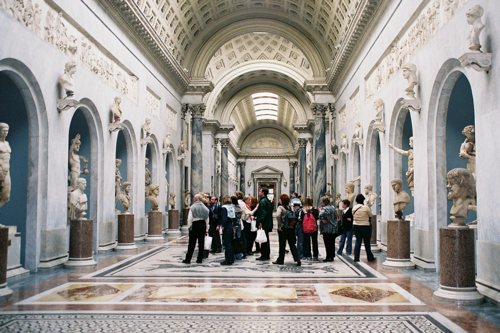
Friday
In a city of nuns, I’ve never seen so many: nuns in khaki, nuns in blue, nuns in crisp, dazzling white. They stand in groups of three or four, talking quietly. Some pull rosaries through their fingers. The whole of Piazza San Pietro is quiet—quiet enough to hear the water pouring into the basins of the fountains. A flag flaps lightly, and pigeons rise past the obelisk.
A street away, in front of Castle San Angelo, at least a hundred white trucks are parked bumper to bumper, each with a satellite dish on the roof. Cameramen in vests chew paninis; two reporters pass a hot dog back and forth.
Today seems an especially bad day to die: The first of April, and the weather is perfect, the apples flowering, the nectarines flowering, the persimmons just starting. Spring is not so much a season in Rome as an onslaught of colors: silver, gold, green. This morning the birds were loud enough to wake us, singing on our terrace, racing past the gutters.
I look up at John Paul’s bedroom window and think: If he is on his back, he can watch the clouds flying past the cupola—huge anvils of cumulus, pale and full of shoulders. The wind slowly tears them to shreds. Thin blades of light slip through and touch down everywhere.
Saturday
The front three pages of every newspaper are about the pope. The Corriere della Sera runs 26 pages of coverage. Even on the pop stations they talk about him, long bursts of Italian between Lionel Ritchie and the Bee Gees. Il Papa, they say, il Papa. Across town he is burning up, his breathing is failing, his kidneys are failing. Every person we run into, at the market, in front of our apartment, seems to know something new. He is conscious, he is unconscious, he is recognizing his staff, he is not in a coma. Already they’ve given him the Sacrament of the Infirm, and the special communion you only get when you’re hours away.
It seems impossible but today is more beautiful than yesterday. The sky is a depthless, flawless cobalt. Everywhere the little chamomile daisies open their white faces to the sun. The lawns look like they are covered with snow.
A wind lifts great clouds of pollen out of the cypresses. Bells toll. Around the world, prayers gather and fly toward us, hurrying past our windows on the way to the Vatican from Brazil, from China, from Poland.
More than three miles of artwork hang in the Vatican Museums, and the pope could have any of it brought in front of him: Raphael, Michelangelo, Caravaggio, Fra Angelico. Instead he wants to hear something read from the Bible in Polish.
By noon, maybe 50,000 people are gathered in the piazza, gazing up at the windows of his apartment.
Saturday Night
All down Via della Conciliazione, camera lights glow white. Maybe a thousand lenses aim toward the basilica: Women with glossy handbags give interviews; priests in white vestments give interviews. Everyone waits; every journalist tries to make a story out of the waiting.
The sky is that heart-breaking violet you see in Italy on very clear nights, purple pocked with the gold of a few stars. Figures mill on rooftops, on top of the colonnade. Every street near the Vatican has become a promenade. Candles burn here and there.
I have never seen so many people in the piazza, not on Christmas, not on Easter. Three windows of the pope’s apartments are lit. Along the whole top floor, only those windows glow. I can’t help but wonder if things are frantic in there, behind his curtains, if doctors are rushing back and forth.
A bald man in Nikes and a suit stands a little apart, his head bowed. As I watch, two separate photographers crouch in front of him and take a dozen exposures each. Maybe a dozen priests gather on the left side of the basilica steps and take turns praying quietly into a microphone. Mostly they do rosaries, Hail Marys, over and over. The crowd murmurs along.
Men with huge cameras push through the crowd. They say John Paul II was the first pope to live in the 24-hour media cycle, and it is obvious he’s dying in one. Everything is filmed; everyone is filming. Raised arms hold cell phones, digital cameras. If the pope could look over his sill, he’d see a sea of faces strobed by a thousand flashbulbs. Four oversized television screens show pilgrims, show the cathedral, show a close-up of St. Peter’s beard.
A bald man in Nikes and a suit stands a little apart, his head bowed. As I watch, two separate photographers crouch in front of him and take a dozen exposures each.
In front of the basilica, one of the priests takes the microphone and sings a song I don’t recognize. His voice is almost impossibly sweet. The crowd sings along.
The pope dies just after 9:30. Inside his apartment, a cardinal says his name three times. A beautiful girl in denim beside me weeps silently. The bells start, or maybe it’s just one bell, clanging over and over again. It echoes off the cobbles, off the pillars, off the gathered heads.
I think maybe I’ll see something thin and glorious slip out of the sky, but nothing comes. The piazza is quiet, except for the bell and the water spilling into the fountains. I think of my sons, a mile away, asleep behind their doors. I think: This is going to happen to all of us.


